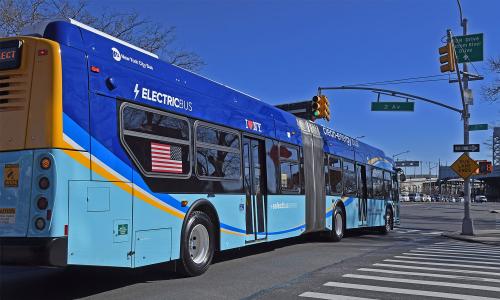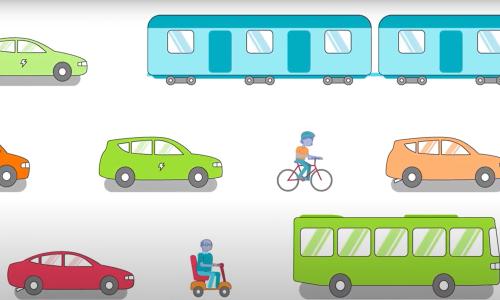Heavy-duty vehicles, ranging from delivery trucks to tractor trailers, transport nearly everything we use each day—but they’ve got a huge pollution problem.
What is a heavy-duty vehicle?
Most passenger cars and trucks are classified as light-duty vehicles. But the biggest polluters on the road are medium- and heavy-duty vehicles—those vehicles weighing more than 10,000 pounds—including everything from medium-duty pick-ups to delivery trucks, tractor trailers, buses, garbage trucks, and cement mixers. These vehicles provide vital services for municipalities, construction, and industry and they transport large quantities of food, goods, or people.
Without them, we’d have empty supermarket shelves, stranded commuters, and shuttered construction sites and factories.
The problem with heavy-duty vehicles
Heavy-duty vehicles play an outsized role in our economy but they also generate an outsized share of global warming emissions. While heavy-duty vehicles make up just ten percent of the vehicles now on the road, they generate more than 25 percent of the total global warming emissions from the transportation sector—the sector that’s already contributing the largest share of global warming emissions. Carbon dioxide, methane, and nitrous oxide are common heat-trapping gases that act like a blanket in the atmosphere to cause global warming.
As the United States moves more and more freight each year, the challenge of reducing emissions in this sector continues to grow.
In addition to negative climate impacts, heavy-duty trucks are a primary source of dangerous tailpipe pollution that contributes to a variety of serious public health issues, including increased asthma rates, heart and lung disease, and certain types of cancer. Historically, Black, Indigenous, People of Color (BIPOC) communities and socioeconomically disadvantaged neighborhoods have borne the brunt of emissions from heavy-duty vehicles. While overall air pollution has decreased since the 1980s, these disproportionate exposures continue today.
But we don’t have to keep driving in this direction.
By switching our diesel fleets of heavy-duty vehicles to fleets powered by electricity, we can significantly reduce toxic tailpipe emissions that are contaminating the environment and harming our health. It is critical that we act now to curb the emissions that heavy-duty trucks produce.
What kind of air pollution do heavy-duty vehicles cause?
Most heavy-duty trucks on the road today are powered by diesel engines, the exhaust from which poses a direct threat to human health and the environment.
Diesel engines emit a mixture of pollutants including:
- Nitrogen Oxides (NOx). Diesel-powered trucks are a major source of NOx emissions, especially in urban neighborhoods. NOx emissions are not only dangerous on their own, causing lung irritation and weakening the body’s defense against infections, they also react with other pollutants in the presence of sunlight to form ground-level ozone.
- Ground-level Ozone (O3). Ozone high in the atmosphere protects us from harmful ultraviolet rays; at ground level, though, O3 inflames and constricts airways, causing coughing and shortness of breath, aggravating asthma and other lung diseases. Long-term exposure can also lead to heart disease.
- Particulate Matter (PM). The soot-filled plumes of exhaust we see from vehicle tailpipes are made of high concentrations of PM. These microscopic particles can penetrate deep into the lungs, aggravating respiratory problems and posing serious threats to the immune system. Diesel PM from trucks contributes substantially to pollution-related cancer risk.
In addition, all vehicles emit PM from tire wear and the use of their brakes. These emissions are strongly related to a vehicle’s weight, which means tire wear and break use in heavy-duty trucks pose a particularly serious issue, especially for the communities alongside freeways. Eliminating tailpipe pollution can go a long way toward reducing local transportation pollution but, regardless of how heavy-duty vehicles are powered, systemic solutions are needed to reduce these other PM emissions.
An environmental injustice
Many neighborhoods and communities, especially those in more densely populated areas of the country, are located near highways. As trucks carrying our food and other goods travel these highways, they leave behind high concentrations of harmful pollution in the neighborhoods nearby. Low-income BIPOC communities that already face several heath inequities are disproportionately affected by heavy-duty vehicle pollution with higher rates and increased exposure to pollutants.
Research has also shown a significant relationship between ground-level ozone concentrations and daily mortality rates in these communities.

The benefits of switching to electric heavy-duty vehicles
Electric vehicles are available and road-ready now. Because they produce no tailpipe emissions, electric vehicles reduce many of the health and climate problems caused by vehicles that run on fossil fuels. What’s more, electric heavy-duty vehicles offer drivers and fleet owners lower and more predictable operating costs.
While the upfront cost is higher for an electric heavy-duty vehicle today, its owner will spend less money on fuel and maintenance over the vehicle’s lifetime, making it a more cost-efficient option. Plus, as battery prices continue to decline rapidly, the upfront costs of electric trucks are almost certain to come down, further tipping the economics in their favor.
Cleaning up diesel trucks
Even as we move toward an electrified transportation sector, we must also make sure that all new diesel trucks sold have lower emissions of NOx and particulate pollution and go further on a gallon of fuel than ever before. Vehicles sold today can remain on the road for 30 years and, in the case of tractor-trailers, might log upwards of a million miles. This makes it critical to ensure that heavy-duty vehicles are efficient as possible and that we adopt and enforce strict emissions limits as we shift away from fleets powered by fossil fuels.




